National University of Singapore
The National University of Singapore (NUS) is a national research university in Singapore. Founded in 1905 as the Straits Settlements and Federated Malay States Government Medical School, NUS is the oldest autonomous university in the country.[6] It offers degree programmes in a wide range of disciplines at both the undergraduate and postgraduate levels, including in the sciences, medicine and dentistry, design and environment, law, arts and social sciences, engineering, business, computing, and music.[7]
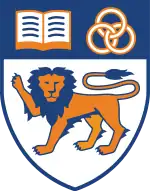 | |
Former names | Straits Settlements and Federated Malay States Government Medical School (1905–1921) King Edward VII College of Medicine (1921–1949) University of Malaya, Singapore campus (1949–1962) University of Singapore (1962–1980) Nanyang University (1956–1980) |
|---|---|
| Type | Autonomous university[1] |
| Established | 1905 (as King Edward VII College of Medicine) 8 August 1980 (as National University of Singapore) |
Academic affiliations | ACU, IARU, APRU, Universitas 21, GEM4, AUN, ASAIHL, NUS High School of Mathematics and Science, Association of Professional Schools of International Affairs, Washington University in St. Louis McDonnell International Scholars Academy,[2] UAiTED |
| Endowment | S$6.46 billion (2020)[3] (US$4.81 billion) |
| Chancellor | Halimah Yacob |
| President | Tan Eng Chye |
| Provost | Ho Teck Hua |
Academic staff | 2,555 (2018)[4] |
| Students | 35,908 (2018)[4] |
| Undergraduates | 27,604 |
| Postgraduates | 8,304 |
| Location | Queenstown, Singapore 1°17′44″N 103°46′36″E |
| Campus | Urban, 150 ha (370 acres) |
| Colours | NUS Orange, NUS Blue[5] |
| Website | nus |
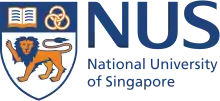 | |
NUS is considered one of the most highly-ranked academic institutions in the world.[8][9] It has consistently featured in the top 100 universities as ranked by the Academic Ranking of World Universities (ARWU), the Quacquarelli Symonds (QS) World University Rankings, and the Times Higher Education (THE) World University Rankings. As of 2022-2023, NUS is 11th worldwide according to QS [10] and 19th worldwide according to THE.[11]
NUS's main campus is located in the southwestern part of Singapore, adjacent to the Kent Ridge subzone of Queenstown, accommodating an area of 170 ha (420 acres).[12] The Duke–NUS Medical School, a postgraduate medical school jointly established with Duke University, is located at the Outram campus;[13] and its Bukit Timah campus houses the Faculty of Law and Lee Kuan Yew School of Public Policy.
NUS includes one Nobel laureate, one Tang Prize laureate and one Vautrin Lud Laureate among its affiliated faculty members and researchers.
History

In September 1904, Tan Jiak Kim led a group of representatives of the Chinese and other non-European communities to petition the Governor of the Straits Settlements, Sir John Anderson, to establish a medical school in Singapore.[14] It was noted by Anderson that there were other petitions prior which were not successful due to concerns over having a sufficient number of students and support from the local community.[15] Tan, who was the first president of the Straits Chinese British Association, managed to raise 87,077 Straits dollars from the community, including a personal donation of $12,000.[15][16][17] On 3 July 1905, the medical school was founded and was known as the Straits Settlements and Federated Malay States Government Medical School. At Anderson's directions, the school was hosted temporarily at a recently emptied block at a Government-run asylum in Pasir Panjang while providing the staff required to run the school.[15]
In 1912, the medical school received an endowment of $120,000 from King Edward VII Memorial Fund, started by physician Lim Boon Keng. Subsequently, on 18 November 1913, the name of the school was changed to King Edward VII Medical School. In 1921, it was again changed to King Edward VII College of Medicine to reflect its academic status.[18][19]
In 1928,[20] Raffles College, a separate institution from the medical school, was established to promote education in arts and social sciences.[21]
University of Malaya (1949–1962)
On 8 October 1949, Raffles College was merged with King Edward VII College of Medicine to form the University of Malaya. The two institutions were merged to provide for the higher education needs of the Federation of Malaya.[22]
The growth of University of Malaya was very rapid during the first decade of its establishment and resulted in the setting up of two autonomous divisions in 1959, one located in Singapore and the other in Kuala Lumpur.[22]
Nanyang University (1955–1980)
In 1955, Nanyang University (abbreviated Nan-tah, 南大) was established on the backdrop of the Chinese community in Singapore.[12]
University of Singapore (1962–1980)
In 1960, the governments of then Federation of Malaya and Singapore indicated their desire to change the status of the divisions into that of a national university.[14] Legislation was passed in 1961, establishing the former Kuala Lumpur division as the University of Malaya, while the Singapore division was renamed the University of Singapore on 1 January 1962.
Present form
The National University of Singapore (NUS) was formed with the merger of the University of Singapore and Nanyang University on 6 August 1980.[23] This was done in part due to the government's desire to pool the two institutions' resources into a single, stronger entity and promote English as Singapore's main language of education. The original crest of Nanyang University with three intertwined rings was incorporated into the new coat-of-arms of NUS.[24]
NUS began its entrepreneurial education endeavours in the 1980s, with the setting up of the Centre for Management of Innovation and Technopreneurship in 1988. In 2001, this was renamed the NUS Entrepreneurship Centre (NEC), and became a division of NUS Enterprise. NEC is currently headed by Wong Poh Kam[25] and its activities are organised into four areas, including a business incubator, experiential education, entrepreneurship development and entrepreneurship research.
NUS has 17 faculties and schools across three campus locations in Singapore – Kent Ridge, Bukit Timah and Outram.
Education
NUS has a semester-based modular system for conducting undergraduate courses. It adopts features of the British system, such as small group teaching (tutorials) on top of regular two-hour lectures, and the American system (course credits). NUS has 17 faculties and schools across three campuses, including a music conservatory.[26]
Reputation and rankings
| University rankings | |
|---|---|
| Global – Overall | |
| ARWU World[27] | 71 (2022) |
| CWTS World[28] | 36 (2021) |
| QS World[29] | 11 (2023) |
| THE World[30] | 19 (2023) |
| USNWR Global[31] | 29 (2022) |
| Regional – Overall | |
| CWTS Asia[28] | 19 (2021) |
| QS Asia[32] | 1 (2020) |
| THE Asia[33] | 3 (2020) |
| USNWR Asia[34] | 2 (2021) |
Overall rankings
The Quacquarelli Symonds (QS) World University Rankings 2022 ranked NUS 11th in the world (1st in Asia).[10]
The Times Higher Education (THE) World University Rankings 2023 placed NUS at 19th worldwide (3rd in Asia Pacific),[11] while the university placed at 24th in the reputation rankings in 2021.[35]
The U.S. News & World Report (USNWR) 2022 Best Global Universities Rankings placed NUS at 29th worldwide.[36]
The Academic Ranking of World Universities (ARWU) 2022 ranked NUS 71st in the world.
In 2020, NUS is ranked 29th among the universities around the world by SCImago Institutions Rankings.[37] NUS placed 28th for 2019-2020[38] and 32nd for 2020-2021[39] globally in the Informatics Institute/METU University Ranking by Academic Performance.[40]
NUS was ranked first in Singapore and Asia Pacific, and 22nd in the world according to the 2018 Times Higher Education World University Rankings,[35] and first in Asia Pacific and 11th in the world according to the 2018 QS World University Rankings.[41] In 2021, NUS was named the world's eighth most international university by the Times Higher Education.[42]
Rankings by subjects / areas
According to the QS World University Rankings by Subject 2022,[43][44] NUS has been placed in the top 10 globally in sixteen subjects. In total, thirty-seven NUS programmes were ranked among world's top 50, making NUS the joint top university in Asia alongside The University of Tokyo:
| Specific Subject (only the subjects ranked within the Top 10 are shown) | NUS's world rank [43] |
| Petroleum Engineering | 1 |
| Engineering - Civil & Structural | 3 |
| Engineering - Chemical | 3 |
| Social Policy & Administration | 4 |
| Geography | 5 |
| Computer Science & Information Systems | 6 |
| Architecture / Built Environment | 6 |
| Materials Science | 7 |
| Engineering - Electrical & Electronic | 8 |
| Chemistry | 8 |
| Engineering - Mechanical, Aeronautical & Manufacturing | 9 |
| Politics & International Studies | 9 |
| Sociology | 10 |
| Linguistics | 10 |
| Law | 10 |
| Environmental Sciences | 10 |
In terms of the broad subject areas as defined by QS, NUS was ranked:
| Broad Subject Area | NUS's world rank [43] |
| Engineering & Technology | 7 |
| Life Sciences & Medicine | 21 |
| Natural Sciences | 15 |
| Arts and Humanities | 12 |
| Social Sciences & Management | 7 |
According to the Times Higher Education World University Rankings by Subjects (2022) [45] which ranked universities in 11 different subjects, NUS was among the world's top 10 in three subjects (computer science, law, and engineering) and top 20 in four subjects (business and economics, physical sciences, clinical & health, and social sciences):
| Subject | NUS's world rank [45] |
| Computer Science | =8 |
| Law | 8 |
| Engineering | 10 |
| Business and Economics | 15 |
| Physical Sciences | 16 |
| Clinical & Health | 17 |
| Social Sciences | 19 |
| Life Sciences | 24 |
| Arts & Humanities | 34 |
| Psychology | 58 |
Faculties and schools
Business

The NUS Business School was founded as the Department of Business Administration in 1965.[48] The NUS Master of Business Administration currently ranks 18th globally according to the Financial Times Global Rankings 2018. NUS also offers MBA degrees in collaboration with overseas universities such as Peking University, UCLA, and Korea University.[49]
Computing

The School of Computing established in 1998, has two departments – Computer Science; and Information Systems and Analytics.[50][51]
Dentistry
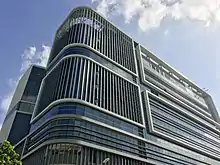
The Faculty of Dentistry had its early beginnings in 1929 as a Department of Dentistry within the King Edward VII College of Medicine.[52] The faculty conducts a four-year dental course leading to the Bachelor of Dental Surgery (BDS) degree.
Design and Engineering
The interdisciplinary College of Design and Engineering (CDE)[53] was launched in 2021, bringing together two pre-existing faculties, the School of Design and Environment (SDE) and the Faculty of Engineering (FoE).
Design and Environment
The School of Design and Environment has three departments: Department of Architecture, Department of the Built Environment, and the Division of Industrial Design.[54]
Engineering
The Faculty of Engineering was launched in 1968. It is the largest faculty in the university and consists of several departments spanning diverse engineering fields.
The NUS Faculty of Engineering was ranked sixth in the world by the Academic Ranking of World Universities for Engineering/Technology and Computer Sciences.[55] It has also been ranked seventh in the world in the subject category of Engineering and Technology by the 2017 QS World University Subject Rankings[56] and 2016-2017 Times Higher Education World University Subject Rankings.[57]
Duke–NUS Medical School
The Duke–NUS Medical School (Duke–NUS) is a graduate medical school in Singapore. The school was set up in April 2005 as the Duke–NUS Graduate Medical School, Singapore's second medical school, after the Yong Loo Lin School of Medicine, and before the Lee Kong Chian School of Medicine. The Duke–NUS Medical School is a collaboration between Duke University in North Carolina, United States and the National University of Singapore.[58]
Humanities and Sciences
The interdisciplinary College of Humanities and Sciences (CHS)[59] was launched in 2020, merging the two largest faculties, the Faculty of Arts and Social Sciences and the Faculty of Science.[60]
Science
The Faculty of Science comprises multiple departments, spanning natural and applied science. The first female Dean of the Faculty of Science was Gloria Lim, who was appointed in 1973. She served a four-year term and was reappointed in 1979, but resigned after one year to allow Koh Lip Lin to continue his post. In 1980, University of Singapore merged with Nanyang University to form NUS, resulting in overlapping posts.[61]
Integrative sciences and engineering
The NUS Graduate School for Integrative Sciences and Engineering (NGS) was established in 2003. The principal purpose of NGS is "to promote integrative PhD research encompassing both laboratory work and coursework programmes which not only transcend traditional subject boundaries but also provides students with a depth of experience about science and the way it is carried out".[62]
Law
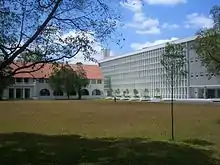
The NUS Faculty of Law was first established as a Department of Law in the then University of Malaya in 1956. The first law students were admitted to the Bukit Timah campus of the university the following year. In 1980, the faculty shifted to the Kent Ridge campus, but in 2006 it relocated back to the Bukit Timah site.[63]
The faculty offers LLB, JD, LLM, and PhD programmes, alongside continuing education and graduate certificate programmes.
Medicine
The Yong Loo Lin School of Medicine at NUS was first established as the Straits Settlements and Federated Malay States Government Medical School in 1905. The School uses the British undergraduate medical system, offering a full-time undergraduate programme leading to the Bachelor of Medicine and Bachelor of Surgery MBBS. For Nursing, the Bachelor of Science (Nursing) conducted by the Alice Lee Centre for Nursing Studies is offered. The department also offers postgraduate programmes in nursing, medicine, and medical science.[64]
Music
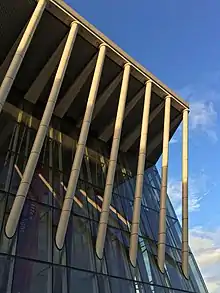
The Yong Siew Toh Conservatory of Music (YSTCM) is a collaboration between NUS and the Peabody Institute of Johns Hopkins University. Singapore's first conservatory of music, YSTCM was founded as the Singapore Conservatory of Music in 2001. The School was renamed Yong Siew Toh Conservatory of Music after a gift was made by the family of the late Dr Yong Loo Lin in memory of his daughter.[19]
Public health
The Saw Swee Hock School of Public Health is Singapore's first and only tertiary education institution for public health.[65] It traces its beginnings to the University of Malaya's Department of Social Medicine and Public Health, formed in 1948.[66]
Public policy
The Lee Kuan Yew School of Public Policy was established in 2004 as an autonomous graduate school of NUS. Although the School was formally launched in 2004, it inherited NUS's Public Policy Programme, which was established in 1992 in partnership with Harvard University's Kennedy School of Government.[67]
University Scholars Programme
The University Scholars Programme (USP) was an undergraduate academic programme established in 2001 in NUS, which comprised a compulsory general education programme. USP admitted 240 undergraduates annually.[68][69] USP students resided in Cinnamon College at the NUS University Town.[68]
Yale-NUS College
The Yale-NUS College is a liberal arts college in Singapore which opened in August 2013 as a joint project of Yale University and the National University of Singapore. It is an autonomous college within NUS, allowing it greater freedom to develop its own policies while tapping on the existing facilities and resources of the main university.[70] Students who graduate receive a degree awarded by NUS.[70] Pericles Lewis, a former professor at Yale, was appointed as the founding president in 2012.[71][72][73][74]
In August 2021, NUS announced that it was going to merge Yale-NUS College with the University Scholars Programme to form a new honours college, NUS College, by 2025[75][76] The merger marks the dissolution of NUS's partnership with Yale University. The last class of Yale-NUS College students were those admitted in 2021, following which Yale-NUS would operate for several years until all of its students have graduated.[77]
Teaching centres
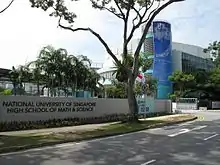
NUS has a variety of teaching centres including:
- Centre for Development of Teaching and Learning (CDTL)[78]
- Centre for Instructional Technology (CIT)[79][80]
- Centre for English Language Communication (CELC)[81]
- Institute of Systems Science (ISS),[82] which offers professional IT continuing education
- Centre for Teaching and Learning CTL at Yale-NUS College[83]
Research
The major research focuses at NUS are biomedical science, physical science, engineering, nanoscience, material science, information technology, humanities, social sciences, and defence.[86][87][88]
One of several niche research areas of strategic importance to Singapore being undertaken at NUS is bioengineering. Initiatives in this area include bioimaging, tissue engineering and tissue modulation.[89]
The university has received a number of grants from the Bill & Melinda Gates Foundation for research into areas including vaccine development,[90] water treatment,[91][92] mobile devices in healthcare,[93] iris recognition,[94] synthetic antibodies,[95] tuberculosis,[96] and government response to the COVID-19 pandemic in Asia.[97]
Research institutes and centres
Currently, NUS hosts 21 university-level research institutes and centres (RICs) in various fields. Four of these RICs have been designated Research Centres of Excellence by the Singapore government — the Cancer Science Institute of Singapore, Centre for Quantum Technologies, Mechanobiology Institute, and Institute for Functional Intelligent Materials.[98]
Besides university-level RICs, NUS also affiliates with other universities to establish research centres and institutes.[99] The Logistics Institute – Asia Pacific is a collaborative effort between NUS and the Georgia Institute of Technology for research and education in logistics.[100] The Next Age Institute, a partnership with Washington University in St. Louis, is the most recent cross-university centre involving NUS, established in February 2015.[101]
Entrepreneurship
NUS began its entrepreneurial education endeavours in the 1980s, establishing the Centre for Management of Innovation and Technopreneurship in 1988. In 2001, this was renamed the NUS Entrepreneurship Centre (NEC), and became a division of NUS Enterprise, the entrepreneurial arm of NUS. Its activities include entrepreneurial education and outreach, technology commercialisation, and a business incubator.[102][103]
The NUS Overseas Colleges (NOC) programme was started in 2001, giving students the opportunity to experience, live, work and study in an entrepreneurial hub. Participants of the programme either spend 6 months or a year overseas, taking courses at partner universities and working in start-ups.[104]
The NUS Industry Liaison Office (ILO) is another department that is involved in the creation of deep tech start-ups. It manages the university's technology transfer and promotes research collaborations with industry and partners. ILO manages NUS intellectual property, commercialises its intellectual assets and facilitates the spinning off of technologies into start-up companies.[105]
Campus facilities and resources
IT and computing services
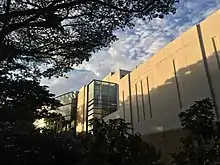
NUS hosts NUSNET, an intranet, which is used in research, teaching, learning and administration. In 2004, a campus-wide grid computing network was deployed, connecting at least 1,000 computers. At the time, it was one of the largest of such virtual supercomputing facilities in the region.[106]
Library services
The NUS Libraries comprises 8 libraries: the Central Library, Chinese Library, CJ Koh Law Library, Hon Sui Sen Memorial Library, the Medical Library, Music Library, Science Library and East Asian Institute Library. As of June 2017, there are 2,354,741 unique titles, and 26,074 microform resources[107] in the collection.[108]
NUS University Town
The NUS University Town (UTown) opened in August 2011. Located at the Kent Ridge campus, it was built on the site of a former golf course.[109] UTown hosts the four residential colleges of NUS and also contains a graduate residence.[110]
Transportation
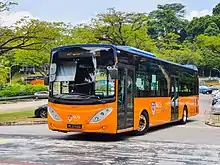
The university has a free Internal Shuttle Bus system that operates across the Bukit Timah and Kent Ridge campuses.[111]
Student accommodation
NUS has three types of student accommodation: halls of residence, student residences, and residential colleges. There are about 6,000 residential places distributed between halls of residence and student residences on campus, in addition to around 4,100 students who live in the residential colleges and graduate residences.[112]
Halls of residence
NUS has 7 Halls of Residence with about 3,000 residential places. A points system, based on co-currciular activities and leadership roles, is used to allocate residential places to students. Halls have their own interest groups and student productions in addition to university-wide student co-curricular activities. Halls compete with each other in the Inter-Hall Games.[113]
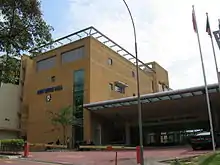
The Halls of Residence are:[114]
- Eusoff Hall
- Kent Ridge Hall
- King Edward VII Hall
- Raffles Hall
- Sheares Hall
- Temasek Hall
Student residences
NUS has two student residences — Prince George's Park Residences and UTown Residences — for undergraduate and graduate students.[115] The residences are arranged in clusters of 11 to 15 single rooms, with shared kitchen and bathroom facilities. The UTown Residences also has apartments for students.[116]
Residential colleges
NUS also houses residential colleges, which are modeled after the college systems of universities. Like halls, residential colleges have unique co-curricular activities. Residential colleges also have their own academic programmes, with general education requirements differing from each other and the rest of the university. The academic programmes in residential colleges take place in seminars.[117]
Cinnamon College/West Wing
Cinnamon College housed the University Scholars Programme (USP) until the 2021 intake. Together with the current Yale-NUS College Campus (which has been renamed the "West Wing"), the college will house the NUS College from the 2022 intake onwards. USP students and faculty are accommodated in 600 rooms.[118]
Tembusu College
Tembusu College was the second residential colleges in NUS University Town. Tembusu houses mainly first and second-year undergraduates, in addition to resident faculty, visiting scholars and graduate fellows.[119] The former founding Rector of Tembusu College is Singapore's Ambassador-at-Large and former United Nations Ambassador Tommy Koh, who is also the former Dean of the NUS Faculty of Law.[120]
College of Alice & Peter Tan
The College of Alice & Peter Tan (CAPT) is a Residential College for all NUS undergraduates which emphasizes active citizenship and community engagement. It provides a two-year academic programme.[121]
Residential College 4
Residential College 4 (RC4) is another Residential College in NUS.[122]
Ridge View Residential College
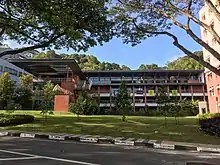
Ridge View Residential College (RVRC) was formally established in April 2014, housed in the former Ridge View Residences. It is the only residential college that is situated outside University Town. The site was the former location for Kent Ridge Hall until November 2002. In November 2015, an annex building to RVRC was constructed. It was completed in February 2017.[123]
List of principal officers
The following table is a list of the principal officers of the National University of Singapore's predecessors. Note that the office of the President of Raffles College was renamed Principal of Raffles College from 1938.[124]
| Principals (King Edward VII Medical College) |
Presidents and Principals (Raffles College) | ||
|---|---|---|---|
| 1905–1909 | Gerald Dudley Freer | 1928–1931 | Richard Olaf Winstedt |
| 1909–1918 | R. D. Keith | 1932–1934 | James Watson |
| 1918–1929 | G. H. MacAlister | 1935–1937 | Frederick Joseph Morten |
| 1929–1947 | George V. Allen | 1937–1938 | Alexander Keir |
| 1947–1949 | D. W. G. Faris | 1938–1941 | George McOwan |
| 1949–present | Bill Patiten | 1946–1948 | W. E. Dyer |
| 1948–1949 | George V. Allen | ||
Alumni
Since its inception in 1905, NUS has had many distinguished alumni from Singapore and Malaysia, including 4 Singaporean prime ministers and presidents, 2 Malaysian prime ministers, politicians, judiciaries, business executives, educators and local celebrities. It counts among its graduates heads of states Abdul Razak Hussein, Benjamin Sheares, Goh Chok Tong, Mahathir Mohamad and S. R. Nathan. The first prime minister of Singapore, Lee Kuan Yew, attended Raffles College briefly before the Second World War.
A number of its graduates are also notable politicians such as Rais Yatim,[125] Malaysia's former minister for information, communications and culture, Ng Eng Hen, Singapore's minister of defence,[126] and S. Jayakumar, Singapore's former deputy prime minister, United Nations representative, and minister for law, home affairs, labour, and foreign affairs.[127]
Many of Singapore's business leaders come from NUS, including as former chairman of the Singapore Exchange and Singapore Tourism Board Chew Choon Seng,[128] CEO of the Hyflux Group Olivia Lum,[129] CEO of the Temasek Holdings Ho Ching,[130] chairman of SPRING Singapore Philip Yeo[131] and CEO of Razer Inc Min-Liang Tan.[132]
In international politics, NUS counts among its graduates former director-general of the World Health Organization Margaret Chan,[133] former president of United Nations Security Council Kishore Mahbubani,[134] and vice-president of the International Olympic Committee Ng Ser Miang.[135]
NUS served as Singapore's only law school for half a century, until the Singapore Management University was set up in 2007. Many of Singapore's judges and lawyers come from the school. This includes Singapore's minister for law and for home affairs K. Shanmugam,[136] the fourth Chief Justice of Singapore Sundaresh Menon[137] and the third Chief Justice of Singapore Chan Sek Keong.[138]
In academia, NUS faculty include former vice-president of finance for the University of Virginia and Cornell University Yoke San Reynolds,[139] and former vice-chancellor of the University of Hong Kong Wang Gungwu.[140]
 Lee Kuan Yew, first prime minister of Singapore
Lee Kuan Yew, first prime minister of Singapore Goh Chok Tong, Singapore's second prime minister
Goh Chok Tong, Singapore's second prime minister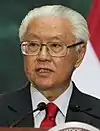 Tony Tan Keng Yam, Singapore's seventh president
Tony Tan Keng Yam, Singapore's seventh president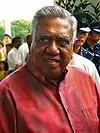 S. R. Nathan, Singapore's sixth and longest-serving president
S. R. Nathan, Singapore's sixth and longest-serving president.jpg.webp) Mahathir Mohamad, fourth and seventh prime minister of Malaysia
Mahathir Mohamad, fourth and seventh prime minister of Malaysia Margaret Chan, director-general of the World Health Organization
Margaret Chan, director-general of the World Health Organization Kishore Mahbubani, former president of the United Nations Security Council
Kishore Mahbubani, former president of the United Nations Security Council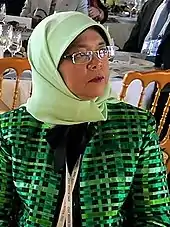 Halimah Yacob, Singapore's eighth and current president
Halimah Yacob, Singapore's eighth and current president Ng Eng Hen, Singapore's current defence minister
Ng Eng Hen, Singapore's current defence minister Sha'ari Tadin, member of Parliament and founder of Singapore Central Council (Majlis Pusat Singapura)
Sha'ari Tadin, member of Parliament and founder of Singapore Central Council (Majlis Pusat Singapura)
See also
- National University Hospital
- Nanyang University
- S*, a collaboration between seven universities and the Karolinska Institutet for training in bioinformatics and genomics
References
- "Post-secondary education". Ministry of Education, Singapore. Ministry of Education, Singapore. Archived from the original on 5 April 2008. Retrieved 11 June 2015.
- "McDonnell International Scholars Academy". Global. Archived from the original on 30 September 2020. Retrieved 5 August 2019.
- "Financial Report 2020" (PDF). National University of Singapore and its Subsidiaries. 2021. p. 76.
- "Annual Report 2018" (PDF). National University of Singapore. Archived (PDF) from the original on 1 February 2019. Retrieved 1 February 2019.
- Corporate Colours - website NUS
- "Towards an "entrepreneurial university" model to support knowledge-based economic development: the case of the National University of Singapore, Poh-Kam Wong, Yuen-Ping Ho, Annette Singh". ScienceDirect. 2007. pp. 941–958. doi:10.1016/j.worlddev.2006.05.007.
- "National University of Singapore (NUS)". Top Universities. QS Top Universities. Retrieved 14 January 2022.
- "QS World University Rankings 2021". Top Universities. 28 May 2020. Archived from the original on 9 June 2020. Retrieved 26 November 2020.
- "QS University Rankings: Asia 2021". Top Universities. 19 November 2020. Archived from the original on 24 October 2018. Retrieved 26 November 2020.
- "QS World University Rankings 2023". QS World University Rankings 2023. Retrieved 16 October 2022.
- "Times Higher Education World University Rankings 2023". Times Higher Education. Retrieved 15 October 2022.
- "History". NUS Bulletin. National University of Singapore. Archived from the original on 12 March 2017. Retrieved 29 January 2019.
- "About Duke-NUS Medical School". Duke School of Medicine.
- Loo Lay Yen. "National University of Singapore: A Brief Chronological History". Lib.nus.edu.sg. Archived from the original on 20 June 2016.
- "GOVERNMENT MEDICAL SCHOOL FOR MALAYA". eresources.nlb.gov.sg. The Singapore Free Press and Mercantile Advertiser (Weekly). 5 October 1905. Archived from the original on 21 March 2021. Retrieved 29 October 2020.
- Zaccheus, Melody (10 February 2019). "Shedding light on life and legacy of Peranakan pioneer Tan Kim Seng". The Straits Times. Archived from the original on 21 March 2021. Retrieved 29 October 2020.
- "A Legacy of Giving". medicine.nus.edu.sg. Archived from the original on 21 March 2021. Retrieved 29 October 2020.
- Tan; Soo, Joanna Hwang. "King Edward VII College of Medicine | Infopedia". eresources.nlb.gov.sg. Retrieved 30 July 2021.
- "Our History - NUS Yong Loo Lin School of Medicine". NUS Yong Loo Lin School of Medicine. Retrieved 30 July 2021.
- "National University of Singapore website – Milestones". Nus.edu.sg. Archived from the original on 3 April 2012.
- Guay; Ling, Ee. "Raffles College | Infopedia". eresources.nlb.gov.sg. Retrieved 30 July 2021.
- corporate@um.edu.my. "Our History". um.edu.my. Retrieved 30 July 2021.
- "History". National University of Singapore. Archived from the original on 12 March 2017. Retrieved 29 June 2019.
- "Milestones". National University of Singapore. Archived from the original on 15 October 2007. Retrieved 11 August 2007.
- Chng, Grace (20 May 2012). "Start-up godfather". The Straits Times. Archived from the original on 10 June 2012.
- "National University of Singapore (NUS)". Ministry of Education, Singapore. Retrieved 30 July 2021.
- "ARWU World University Rankings 2022 - Academic Ranking of World Universities 2022 - Shanghai Ranking - 2022". www.shanghairanking.com. Retrieved 15 October 2022.
{{cite web}}: CS1 maint: url-status (link) - "CWTS Leiden Ranking 2021". www.leidenranking.com. Retrieved 11 August 2021.
- "QS World University Rankings 2023". QS Quacquarelli Symonds. Retrieved 15 October 2022.
{{cite web}}: CS1 maint: url-status (link) - "THE World University Rankings 2023". Retrieved 15 October 2022.
{{cite web}}: CS1 maint: url-status (link) - "US News Best Global Universities Rankings". www.usnews.com. Archived from the original on 28 October 2014. Retrieved 29 October 2021.
- "QS University Rankings: Asia 2020". Archived from the original on 24 October 2018. Retrieved 25 November 2018.
- "Asia University Rankings 2020". Archived from the original on 24 December 2020. Retrieved 20 October 2019.
- "US News best Best Global Universities in Asia". www.usnews.com. Archived from the original on 28 October 2014. Retrieved 10 May 2020.
- "World Reputation Rankings 2021". Times Higher Education. Retrieved 15 October 2022.
{{cite web}}: CS1 maint: url-status (link) - "2022 Best Global Universities Rankings".
- "SCImago Institutions Rankings - Higher Education - All Regions and Countries - 2020 - Overall Rank". www.scimagoir.com. Archived from the original on 22 April 2019. Retrieved 11 June 2019.
- "2019–2020 Rankings". University Ranking by Academic Performance. Archived from the original on 18 December 2019. Retrieved 31 July 2021.
- "World Ranking". University Ranking by Academic Performance. Archived from the original on 6 December 2020. Retrieved 31 July 2021.
- "Middle East Technical University, Graduate School of Informatics".
- "QS World University Rankings Results 2018". QS Quacquarelli Symonds. Archived from the original on 27 July 2018. Retrieved 2 November 2020.
- "Most international universities in the world 2018: top 200". Times Higher Education. Archived from the original on 21 March 2021. Retrieved 7 June 2018.
- "QS World University Rankings by Subject 2022". Top Universities. Retrieved 16 October 2022.
- "Sixteen NUS programmes in global top 10". NUS ranked top 10 globally in 16 subjects. Retrieved 15 October 2022.
- "World University Rankings by subject". Times Higher Education (THE). Retrieved 15 October 2022.
- "Best universities for graduate jobs: Global University Employability Ranking 2021". Student. 24 November 2021. Retrieved 15 October 2022.
- "QS Graduate Employability Rankings 2018". www.topuniversities.com. Archived from the original on 7 January 2019. Retrieved 7 June 2018.
- "Faculty & Departments". Bschool.nus.edu. 31 July 2010. Archived from the original on 2 September 2011. Retrieved 11 August 2015.
- "About Us – Profile- Overview". Bschool.nus.edu. 28 January 2013. Archived from the original on 3 July 2015. Retrieved 11 August 2015.
- "NUS – School of Computing". Comp.nus.edu.sg. Archived from the original on 21 March 2021. Retrieved 11 August 2015.
- "NUS Computing - Master's in Computer Science". comp.nus.edu.sg. Retrieved 30 July 2021.
- "NUS - Faculty of Dentistry". Archived from the original on 31 December 2010.
- "College of Design and Engineering". nus.edu.sg. Retrieved 16 December 2021.
{{cite web}}: CS1 maint: url-status (link) - "NUS School of Design and Environment". nus.edu.sg. Retrieved 15 August 2021.
{{cite web}}: CS1 maint: url-status (link) - "Academic Ranking of World Universities in Engineering/Technology and Computer Sciences - 2016 - 2016 Top 100 Universities in Natural Sciences and Mathematics - ARWU-FIELD 2016". www.shanghairanking.com. Archived from the original on 16 October 2019. Retrieved 13 October 2017.
- "Engineering and Technology". 3 March 2017. Archived from the original on 9 August 2017. Retrieved 13 October 2017.
- "World University Rankings 2016-2017 by subject: engineering and technology". 20 September 2016. Archived from the original on 21 March 2021. Retrieved 13 October 2017.
- Kamei, Cook; Puthucheary, Starmer (2012). "21st Century Learning in Medicine: Traditional Teaching versus Team-Based Teaching". www.iamse.org/. pp. 57–64. doi:10.1007/BF03341758. S2CID 56770146. Archived from the original on 4 November 2013.
- "Home Page – NUS College of Humanities and Sciences". nus.edu.sg. Retrieved 17 April 2021.
{{cite web}}: CS1 maint: url-status (link) - Teng, Amelia (8 December 2020). "NUS launches new interdisciplinary College of Humanities and Sciences". The Straits Times. Retrieved 17 April 2021.
{{cite web}}: CS1 maint: url-status (link) - Chan, Juliana; Chua, Grace; Sim, Shuzhen; Tan, Rebecca (2015). Singapore's Scientific Pioneers (PDF). Singapore: Asian Scientist Publishing Pte Ltd. ISBN 978-981-09-5893-0. Archived (PDF) from the original on 21 March 2021. Retrieved 24 June 2020.
- "NGS – NUS Graduate School for Integrative Sciences and Engineering". Nus.edu.sg. 3 August 2015. Archived from the original on 21 March 2021. Retrieved 11 August 2015.
- "History & Milestones - NUS Law". NUS Law. Retrieved 30 July 2021.
- "Alice Lee Centre for Nursing Studies-Yong Loo Lin School Of Medicine". Retrieved 30 July 2021.
- "The School". Saw Swee Hock School of Public Health. Archived from the original on 21 March 2021. Retrieved 24 July 2017.
- "Milestone". Saw Swee Hock School of Public Health. Archived from the original on 21 March 2021. Retrieved 24 July 2017.
- NUS LKYSPP (2015). "Lee Kuan Yew School of Public Policy" (PDF). www.nus.edu.sg. Retrieved 30 July 2021.
- "Overview – University Scholars Programme". usp.nus.edu.sg. Retrieved 30 July 2021.
- "Residential Colleges". Archived from the original on 6 September 2011.
- "FAQs – Yale-NUS College". Archived from the original on 21 March 2021. Retrieved 3 June 2015.
- Fischer, Karin (30 May 2012). "Yale Scholar Will Be First President of New Institution in Singapore". The Chronicle of Higher Education. Archived from the original on 21 March 2021. Retrieved 24 June 2020.
- Davie, Sandra (30 May 2012). "Prof Pericles Lewis named president of Yale-NUS liberal arts college".
- "'Not the job' of Yale-NUS College to tell students what to think". AsiaOne. 30 May 2012. Archived from the original on 21 March 2021. Retrieved 9 June 2012.
- "Yale's Pericles Lewis to be inaugural Yale-NUS president". Yale News. 30 May 2012. Archived from the original on 21 March 2021. Retrieved 24 June 2020.
- "Yale-NUS to be merged into a new college in 2025 as NUS seeks interdisciplinary education at scale". Yale News. Retrieved 4 January 2022.
{{cite web}}: CS1 maint: url-status (link) - "NUS College". NUS College. Retrieved 4 January 2022.
{{cite web}}: CS1 maint: url-status (link) - Davie, Sandra (5 September 2021). "What's behind the decision to close Yale-NUS College?". The Straits Times. Retrieved 5 September 2021.
- "History, Vision & Mission, Strategies". nus.edu.sg. Retrieved 30 July 2021.
- "CIT - About". cit.nus.edu.sg. Retrieved 30 July 2021.
- "CIT – Quality". Cit.nus.edu.sg. 16 January 2003. Archived from the original on 10 September 2015. Retrieved 11 August 2015.
- "About Us". nus.edu.sg. Retrieved 30 July 2021.
- "About Us". iss.nus.edu.sg. Retrieved 30 July 2021.
- "Yale-NUS College". teaching.yale-nus.edu.sg. Retrieved 30 July 2021.
- "NUS High School celebrates 10 years of math and science education". TODAYonline. Retrieved 21 March 2019.
- "NUS High School of Mathematics and Science". Retrieved 30 July 2021.
- "key areas". nus.edu.sg. Retrieved 30 July 2021.
- "Research Areas & Facilities". Materials Science and Engineering. Retrieved 30 July 2021.
- "Home - Temasek Defence Systems Institute". Temasek Defence Systems Institute. Retrieved 30 July 2021.
- "Research Areas". Biomedical Engineering. Retrieved 30 July 2021.
- "National University of Singapore". Bill & Melinda Gates Foundation. November 2021. Archived from the original on 15 June 2022. Retrieved 15 June 2022.
- "National University of Singapore". Bill & Melinda Gates Foundation. June 2011. Archived from the original on 15 June 2022. Retrieved 15 June 2022.
- "National University of Singapore". Bill & Melinda Gates Foundation. March 2013. Archived from the original on 15 June 2022. Retrieved 15 June 2022.
- "National University of Singapore". Bill & Melinda Gates Foundation. September 2021. Archived from the original on 15 June 2022. Retrieved 15 June 2022.
- "National University of Singapore". Bill & Melinda Gates Foundation. October 2011. Archived from the original on 15 June 2022. Retrieved 15 June 2022.
- "National University of Singapore". Bill & Melinda Gates Foundation. October 2008. Archived from the original on 15 June 2022. Retrieved 15 June 2022.
- "National University of Singapore". Bill & Melinda Gates Foundation. March 2017. Archived from the original on 15 June 2022. Retrieved 15 June 2022.
- "National University of Singapore". Bill & Melinda Gates Foundation. June 2020. Archived from the original on 15 June 2022. Retrieved 15 June 2022.
- Shafeeq, Syarafana (7 October 2021). "New NUS research centre to study functional intelligent materials with uses such as in artificial organs". The Straits Times. Retrieved 10 October 2021.
{{cite news}}: CS1 maint: url-status (link) - "Research Institutes". nus.edu.sg. Archived from the original on 3 September 2011.
- "Logistics Education at NUS". Edumaritime.com. Archived from the original on 21 March 2021. Retrieved 24 June 2020.
- "Home". www.fas.nus.edu.sg. Archived from the original on 21 March 2021. Retrieved 16 February 2020.
- "S'pore start-up incubator sets up US hub". Archived from the original on 29 December 2016. Retrieved 29 December 2016.
- "Our Purpose - NUS Enterprise". NUS Enterprise. Retrieved 30 July 2021.
- Tan, Eng Chye (25 April 2016). "Which university? Which course of study?". The Straits Times. Archived from the original on 21 March 2021. Retrieved 7 December 2016.
- "NUS researchers turn waste paper into oil absorbent". Archived from the original on 29 December 2016. Retrieved 29 December 2016.
- "NUS And SCS Unveil Biggest Supercomputing Grid in the Region". NCS. 16 November 2004. Archived from the original on 15 June 2013.
- "Library Statistics 2016/2017". Libportal.nus.edu.sg. Archived from the original on 8 July 2017. Retrieved 11 August 2015.
- "Library Statistics 2016/2017". ocr. 19 January 2018. Archived from the original on 20 January 2018.
- Leow, Si Wan (1 April 2010). "August 2011 start for UTown at NUS". Asia One. Archived from the original on 3 January 2019. Retrieved 25 June 2020.
- "About UTown". Archived from the original on 3 April 2010.
- "Getting around NUS". NUS Office of Campus Amenities. Archived from the original on 21 March 2021. Retrieved 25 February 2020.
- "Graduates". NUS Office of Housing Services. Archived from the original on 21 March 2021. Retrieved 25 February 2020.
- "Home | IHG 18/19". IHG 18/19. Retrieved 30 July 2021.
- "NUS Halls of Residence". National University of Singapore. Archived from the original on 21 March 2021. Retrieved 30 July 2020.
- "Student Residences". National University of Singapore. Archived from the original on 15 February 2009. Retrieved 11 August 2007.
- "UTown Residence " University Town". Utown.nus.edu.sg.
- "Your residential options @NUS" (PDF). Retrieved 30 July 2021.
- "Cinnamon College (USP) – University Scholars Programme". usp.nus.edu.sg. Retrieved 30 July 2021.
- "About - Tembusu College". tembusu.nus.edu.sg. Retrieved 30 July 2021.
- "Professor Tommy Koh - People - Tembusu College". tembusu.nus.edu.sg. Retrieved 30 July 2021.
- "About Us | The College of Alice & Peter Tan". The College of Alice & Peter Tan. Retrieved 30 July 2021.
- "RC4 Experience – NUS Residential College 4". rc4.nus.edu.sg. Retrieved 30 July 2021.
,
- "Ridge View Annex (RVA) – NUS Office of Estate Development (OED)". uci.nus.edu.sg. Retrieved 30 July 2021.
- Loo Lay Yen. "Our Chancellors and Vice-Chancellors : a biographical sketch : Roll of Honour". Lib.nus.edu.sg. Archived from the original on 7 November 2015. Retrieved 11 August 2015.
- "NUS: Faculty of Law - Alumni". law1.nus.edu.sg. Retrieved 30 July 2021.
- "NUS alumni to comprise almost half of 14th Singapore Parliament". 28 July 2020. Retrieved 30 July 2021.
- "Professor S Jayakumar appointed as NUS Pro-Chancellor". 18 June 2020. Retrieved 30 July 2021.
- "Chew Choon Seng | GIC Board of Directors". GIC. Retrieved 30 July 2021.
- "Olivia Lum, Hyflux Ltd: Profile and Biography". Bloomberg.com. Retrieved 30 July 2021.
- "Ho Ching". Forbes. Retrieved 30 July 2021.
- "Philip L. Yeo, MBA 1976 - Alumni - Harvard Business School". alumni.hbs.edu. Retrieved 30 July 2021.
University of Singapore
- "Min-Liang Tan, Razer Inc: Profile and Biography". Bloomberg.com. Retrieved 30 July 2021.
- "Congratulations to Dr Margaret Chan, one of CNN's 19 Most Important Women in the History of Science - Saw Swee Hock School of Public Health". Saw Swee Hock School of Public Health. Retrieved 30 July 2021.
- "About Kishore Mahbubani - Kishore Mahbubani". Kishore Mahbubani. Retrieved 30 July 2021.
- "NG SER MIANG | Thomson Medical". Thomson Medical. Retrieved 30 July 2021.
- "LawLink" (PDF). 2008. Retrieved 30 July 2021.
- "60 years of legal education". 24 October 2017. Retrieved 30 July 2021.
- "CHAN Sek Keong - NUS Law". NUS Law. Retrieved 30 July 2021.
- "Yoke San Reynolds, U-Va.'s retiring vice president, saved the university nearly $1 billion". The Washington Post. Retrieved 30 July 2021.
- Kumari, Sheena. "Wang Gungwu | Infopedia". eresources.nlb.gov.sg. Retrieved 30 July 2021.
External links
| Library resources about National University of Singapore |
 Media related to National University of Singapore at Wikimedia Commons
Media related to National University of Singapore at Wikimedia Commons- National University of Singapore official site